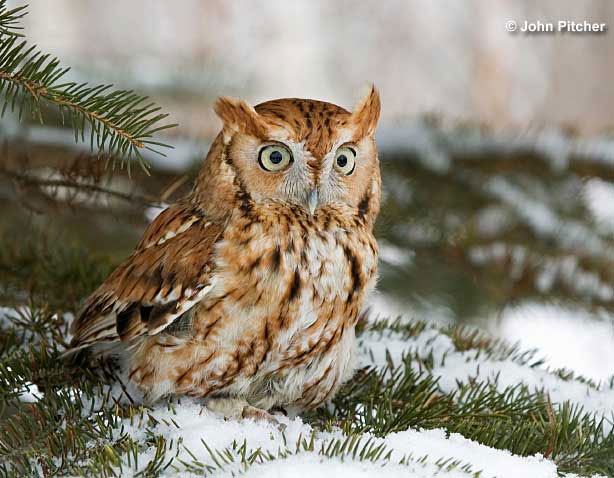The Eastern Screech-Owl (Megascops asio) is an enigmatic bird that lives in a wide range of habitats from forests to urban areas in eastern North America.
They’re small, stocky birds with cryptic plumage which helps them camouflage. Take a closer look at where to find and how to identify them!
On this page
Identification
Eastern Screech-Owls are small but rather stocky birds 6.3-10 inches long with a wingspan of 18-24 inches. Males and females look the same, but female Eastern Screech-Owls are slightly larger.
They have broad and rounded wings, big, rounded heads with ear tufts, yellow eyes and bills, bristled feet, and short and squared tails.
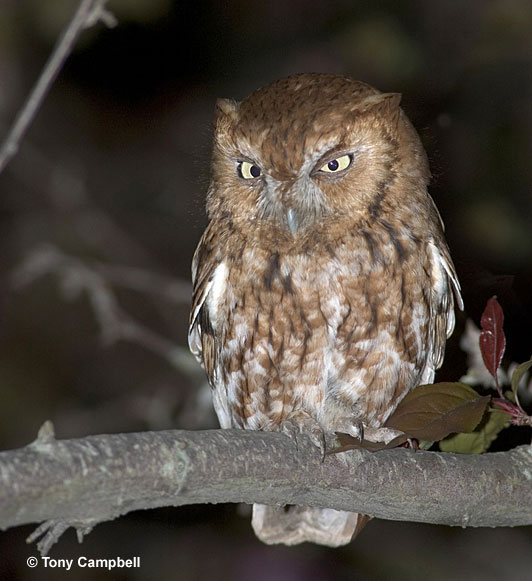
Eastern Screech-Owls have two common color morphs: gray and rufous. The rufous morph, as the name suggests, has rust-colored plumage with dark bands and spots across its body.
The gray morph has a similar plumage pattern but is gray overall. Rufous morph is more common in the south and camouflages well against pine trees and deciduous trees with colorful leaves. The gray morph is more common in the north and is very hard to spot against the bark of hardwood trees.
There’s also a rarer brown morph that is speculated to be the hybrid of the gray and rufous morph. It is only found in the southern part of its range.
Juvenile Eastern Screech-Owls have fluffy gray plumage with very fine darker barring throughout.
Eastern Screech-Owl Sound
Eastern Screech-Owls are very good at blending into their surroundings, so you are more likely to hear rather than see them.
They’re strictly nocturnal, so you’ll only hear their songs and calls at night.
Both the female and male Eastern Screech-Owls sing, and it resembles a whinny of a miniature horse. They may also purr, which lasts for 3-6 seconds and is even in pitch.
Their calls include low hoots, screeching, and sounds similar to barking.
Food
Eastern Screech-Owl’s diet is exclusively carnivorous. They hunt a wide array of creatures, such as insects, small mammals, birds, amphibians, crustaceans, reptiles, and worms.
Depending on the location and availability of food, it can include moths, katydids, crayfish, mice, bats, earthworms, lizards, frogs, spiders, shrews, tadpoles, rabbits, swallows, thrushes, finches, and more.
These owls hunt at night or dusk. They mostly like to sit on a perch, survey their surroundings, and then swoop down to catch their prey from the ground or the foliage.
Sometimes they will also snatch flying insects mid-air. If they manage to catch more than they can consume, they may store it in tree holes for later consumption.
Nesting and Eggs
Eastern Screech-Owls are mostly monogamous in nature and often mate for life. In courtship, they will bow to each other, raise wings, and trill. Pairs often call in duets and preen each other’s feathers.
Eastern Screech-Owls nest in cavities that are on average 10-30 feet above the ground. However, they depend on natural hollows and/or cavities made and enlarged by woodpeckers, squirrels, or rot, since they cannot make one themselves. They also accept nest boxes. Females lay their eggs directly into the cavity and won’t add any material.
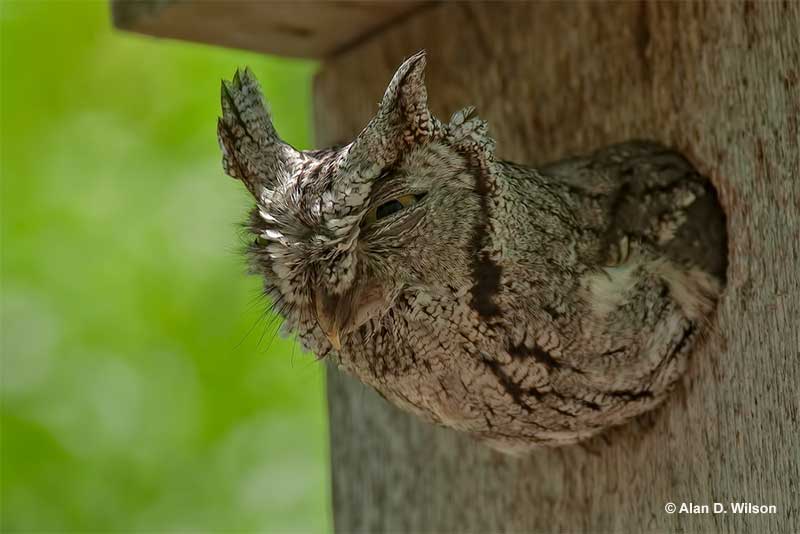
These birds have one brood in a year with 2-8, mostly 4-5 eggs in a clutch. Eastern Screech-Owl eggs are white and just a bit longer and wider than an inch. Incubation takes 26-34 days.
Females are primarily in charge of incubation, whereas males hunt and bring food for the family. The younglings stay in the nest for about 4 weeks and remain close to their parents for another 4-6 weeks.
Current Situation
Eastern Screech-Owls range throughout the eastern United States, some parts of southernmost Canada, and northern Mexico. They are resident throughout their range and can be found in a wide range of habitats below about 4900 feet.
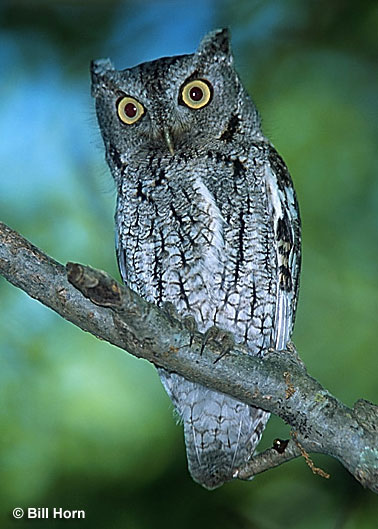
Some Eastern Screech-Owl habitats include urban and suburban areas, deciduous and mixed forests, or really any kind of open areas with some large trees.
These birds are listed as of least concern on the IUCN Red List. They’re currently not threatened, although deforestation and loss of nesting cavities are a problem.
Facts
- Finding an Eastern Screech-Owl can be rather difficult. At night, listen for its distinct calls. During the day, look for pellets of regurgitated bones, fur, and feathers below roosting spots.
- The Eastern Screech-Owl is typically divided into five subspecies, but the distinction is not very clear and some of the variations in plumage and size may be considered clinal.
- In captivity, Eastern Screech-Owls can live for over 20 years. In the wild, the oldest known individual was 14 years old. However, the mortality rate of young owls is very high, up to 70%. This is caused by predation as well as siblicide.
- Eastern Screech-Owls have 14 vertebrae in their necks while humans (and other mammals) only have 7. This enables them to rotate their heads 270 degrees!
- Eastern Screech-Owl’s ear openings are not on the same level. One of them is higher and the other one lower. This helps them to better locate where sound is coming from.
Similar Species
Due to their small size, they can be easy to identify if you’re lucky enough to meet one. We have introduced 2 other owl species that look similar to them despite the fact.
Western Screech Owl
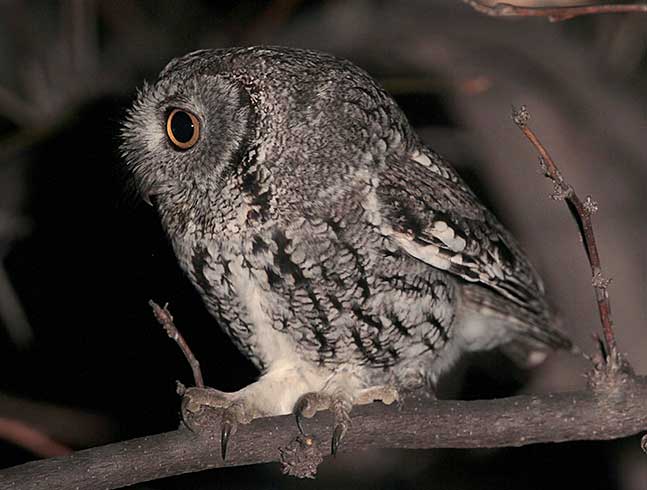
Western Screech Owls have gray plumage and no other morphs. They are only found in western North America and their calls are different as well.
Northern Saw-whet Owl
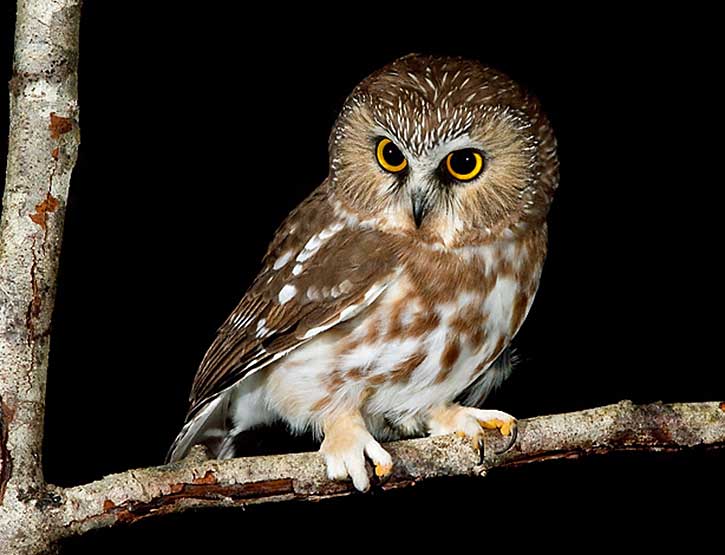
Northern Saw-whet Owls are smaller than Eastern Screech-Owls. They have rounded heads but no ear tufts and their underparts are not as intricately barred.
Frequently Asked Questions
Is the Eastern Screech-Owl rare?
Eastern Screech-Owls are fairly common and inhabit a wide range of habitats. However, due to their cryptic plumage and nocturnal lifestyle, actually seeing one might prove difficult.
What is special about an Eastern Screech-Owl?
Eastern Screech-Owls are one of the smallest owls in North America.
Where do Eastern Screech-Owls live?
Eastern Screech-Owls live in eastern North America, mostly in the eastern United States. They prefer to live in mixed and deciduous forests but can also be found near open areas with large trees as well as in suburban and urban areas.
Why do screech-owls screech at night?
Screech-owls screech at night because they are active during that time. They vocalize to defend their territory, as a part of courtship, or to signal something.
Do Eastern Screech-Owls come out during the day?
Eastern Screech-Owls spend their day resting in tree cavities. They’re strictly nocturnal.
Do screech owls return to the same nest every year?
Screech Owls generally return to the same nest every year.

